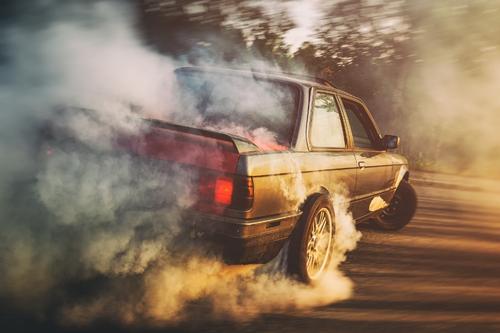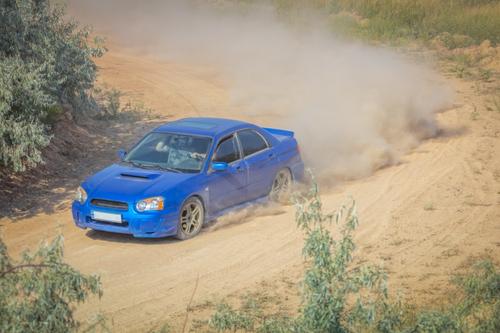Какво е дрифт шофиране и каква е неговата история?

Дрифт шофиране е вид екстремно шофиране, което има много привърженици. Това е автомобилен спорт, който се характеризира с преднамерено приплъзване на задната ос на колата при завой, преминаване в контролиран дрейф при максимално възможна скорост. Ъгълът на задните колела при дрифт шофирането надвишава ъгъла на предните, понякога значително.
Този вид шофиране говори за високо майсторство на шофьора, за умението му да държи под контрол силата на автомобила и да го насочва в нужната посока.
История на дрифт шофирането
Всичко започва през 70-те години в Япония, точно това е родната страна на дрифт шофирането като отделно направление в спорта. Първите дрифт шофьори са уличните състезатели, които усъвършенстват техниката си по криволичещи пътища в планината. Те са използвали дрифт шофирането за по-бързо преминаване по трасетата, а броенето се е извършвало с точност до милисекунда. Ключовата личност в зараждането на дрифтинга е Кунимицу Такахаши. Този японец първо е бил мотоциклетен състезател, но по-късно е продължил кариерата си като автомобилен състезател.
Той има множество победи в професионалния спорт, включително Гран При на Германия през 1961 година по шосейно състезание. В автомобилния спорт го кара да премине авария, след която той започва нов път в кариерата си. В автомобилните състезания Кунимицу Такахаши също е бил успешен, участвал е дори във Формула-1. Японецът слага край на кариерата си, когато е на 47 години.

Стилът му на шофиране дава началото на цяло движение от привърженици на екстремните завои и димящите гуми, оформяйки постепенно нов вид зрелищен професионален спорт.
Втората ключова личност в зараждането на този стил шофиране е Кейчи Цучия, превърнал се по-късно в крал на дрифт шофирането. Този японец има фенове по цял свят, дори е заснел видео за удивителните си умения в дрифтинга. Точно благодарение на него това екстремно шофиране е станало легално. През 1999 година е създадена серията D-1 Grand Prix, и до днес останала най-голямата световна дрифт организация.
Дрифт автомобили
За дрифт автомобилите имат две основни изисквания – те трябва да са със задно задвижване и мощността им трябва да бъде минимум 160 конски сили.
Задно задвижване
Точно това осигурява боксуването на едновременно двете задни гуми.
Максимално олекотяване
Автомобилът за дрифт шофиране трябва да е лек и маневрен, в рамките на разумното, разбира се. Без това няма как да се постигне победа и успешно преминаване през пистите.
Двигател
Тук е важен обемът. Той трябва да работи максимално дълго време в трудни, екстремни условия на силно натоварване. Добре е да е със свръхзареждане.
Окачване
Трябва амортисьорите да са здрави и пружините стегнати. Най-често марката на автомобила за дрифт шофиране е Toyota или Nissan. Най-подходящи автомобили за дрифтинг са Nissan 180-SX, Nissan Silvia, Nissan Skyline, Nissan Laurel, Toyota AE86 и Mazda RX7 (RX8).
Видове дрифт шофиране
Техниките са много и често само един професионалист може да ги различи една от друга.

Hand-breaking drifting
Една от най-лесните, независимо от плашещото ѝ име. Подходяща е за начинаещи, при първите стъпки в дрифт шофирането. Основният плюс на тази техника е, че ако шофьорът допусне грешка, тя може да се поправи с коригиращи резки движения.
Изпълнение: настъпва се съединителят, издърпва се рязко ръчната спирачка и автомобилът поднася. След това съединителят се отпуска.
Hand-breaking drifting тренира контрола на силата и скоростта на рязкостта.
Clutch-Kick drifting
Съединителят се настъпва и отпуска рязко. Точно затова автомобилът поднася толкова рязко.
Yorin drifting
При този вид техника на дрифт шофиране се въвличат всички колела при завоя на трасето.
Kanteria drifting
Завиването става във формата на буква „S“. Kanteria drifting изглежда невероятно ефектно.
Braking drifting
Тази дрифтинг техника се характеризира с настъпването на педала за спирачката и в този същия момент се изписват завои. След като се настъпи спирачният педал, се настъпва съединителят и се дърпа ръчната спирачка, но за не повече от една секунда.
Dynamic drifting
При навлизането в дълъг завой шофьорът бързо отпуска скоростта, коригира, поддържа поднасянето с волана и с бързо настъпване на спирачката. Не добавя още скорост.
Heel-Toe Shifting
Този вид се изразява в превключване на скоростта с пръсти и пета. При това е важно да се запази балансът, плавността, правилното управление, контролът върху работата на спирачките. Тънкостта на техниката се изразява в това, че единият крак може да е едновременно върху два педала, което и осигурява плавно превключване на скоростите.
Jump drifting
Факт: дрифтърите не се движат само напред, наляво-надясно, а и нагоре-надолу. Дрифтингът е, не на последно място, шоу и пилотите трябва да направят всичко възможно, за да осигурят това шоу.
Изпълнение: гумата от вътрешната страна на завоя се изтласква от препятствие или неравност по пистата. Така тежестта на автомобила се премества на другата страна и колата поднася.
Kansei drifting
Интересен вид дрифт шофиране. Автомобилът буквално влита в завоя с висока скорост, шофьорът маха крака си от педала за газта. Тежестта на автомобила преминава към предната ос, възникналото пързаляне се контролира от шофьора с волана и педала за газта.
Long-Slide drifting
Важно изискване при тази техника е високата скорост. Пилотът, с помощта на ръчната спирачка, извършва продължително пързаляне по правата, то приключва със завой под голям ъгъл.
Dirt Drop drifting
С тази техника колата се измества със задните гуми на земя или кален черен път, за да поддържа плъзгането и да влезе в завоя на пистата с необходимата скорост.
Power over drifting
Тази техника се осъществява само с автомобил с висока мощност. За да се влезе в поднасянето, воланът се завърта в посоката, в която трябва да се насочи автомобилът. След това педалът на газта се настъпва докрай, задните гуми губят сцепление с пистата. Всичко това се случва заради високата скорост на автомобила. За да се излезе от завоя на пистата без повреди и аварии, газта се отпуска малко, а воланът се завърта на другата страна.
Side-braking drifting
Разбиването на задните гуми кара дрифт автомобилът да се пързаля буквално настрани.
Chokudori или Swaying drifting
По принцип тази техника се използва след равни участъци на право трасе.
Изпълнение: спирането се случва с помощта на пързаляне. Автомобилът застава под необходимия ъгъл, получава се дълбоко поднасяне на колата. Шофьорът трябва да избере оптималния ъгъл, за да се впише в завоя.
Manji drifting
Рядко може да се види на извито трасе, често – на прости, прави трасета. Ефектно изглежда олюляването на автомобила по целия път. Често се изпълнява за шоу.
Дрифт състезания
Състезанията невинаги са били дуели, по-рано състезателите са шофирали по единично. С времето състезанията са се превърнали в шофиране с оценяване от съдии с точки. Освен зрелището, се оценяват и техническите параметри, така че ефектното шофиране все пак не дава победа на пистата. То трябва и да бъде изпълнено правилно.
Има летни и зимни състезания, правилата на практика са еднакви за всеки сезон. Пистите се подготвят или се намира криволичещо трасе, за да се демонстрира цялата красота и майсторство при навлизането в завоите. Първата задача е да останеш невредим и да стигнеш до финала. И още една – да го направиш по-добре от другите.

Състезанието се състои от квалификации (първи етап) и дуели (втори етап). На японски език тези етапи се наричат Тансо и Цуисо.
На квалификациите всеки пилот има три опита. Първият, при който не се взема предвид трасето, е „загрявката“. На дълга писта се поставя оценка за всичките три опита. Всички пилоти са в началото на трасето с равни условия – всеки има по 100 точки. Всяка грешка води до намаляване броя на точките.
Критерии за оценяване на дрифт шофирането
Техническите параметри на състезание са също толкова важни, колкото и ефектното представяне, а даже за някои съдии това е по-важно.
- Първият важен критерий. Съдиите оценяват траекторията. Обикновено тя се определя преди началото от самите съдии и всеки пилот трябва да се движи точно по нея.
- Вторият оценяван критерий. Оценява се ъгълът на движение на транспортното средство спрямо траекторията.
- Третият задължителен критерий. Скоростта – както е и във всички състезания. Колкото по-висока е, толкова по-добре!
- Четвъртият задължителен критерий. Зрелищността и индивидуалният стил. Това се оценява не само от суровите и безпристрастни съдии, а и от зрителите. В рамките на този критерий се оценява дори и красотата на дима изпод гумите. Този критерий е определящ и най-важен за много дрифт шофьори, той ги вдъхновява за нови подвизи и победа на пистата.
Интересни факти за дрифт шофирането
- Дрифтингът се бърка много с неконтролираното поднасяне на колата. Това е голяма грешка. За второто не е важна мощността на двигателя и дори типът на автомобила. Така че не трябва да се поставят такива етикети.
- Има много компютърни и мобилни игри, посветени точно на дрифтинга, например CarX Drift Racing.
- „Бързи и яростни: Токио дрифт“ е един от филмите за този вид спорт.
- Ако при състезание нито един съдия не е видял нито една грешка в техниката на изпълнение, главният съдия казва „Аникуя“ и всички присъстващи го повтарят радостно.
- За много як дрифт се смята лекото съприкосновение на задницата на колата с бариерата, това се нарича „Kiss the wall“.
- Двете гуми могат да се повредят при дрифт за по-малко от пет минути. Дрифтинг през уикенда е нещо много яко, но излиза скъпо – отиват пет и повече комплекта гуми.
- Има специални гуми за дрифтинг – димът от тях е цветен и дори мирише.
- Ръчната спирачка се дърпа на скорост, достигаща 120 км в час.
- Ръчната спирачка се ъпгрейдва и модифицира често, прави се по-дълга, тъй като това е основният инструмент в дрифт шофирането.
- Двигателите на най-мощните дрифт автомобили са с мощност до 700 конски сили.
Подарете дрифт шофиране!
Ако говорим за развлечения, способни да дадат и специфични умения, които може да се приложат и в реалния живот, то дрифт шофирането заема лидерски позиции. То позволява не само да усетите драйва от управлението на мощен автомобил, но и може да Ви научи да действате инстинктивно в сложни ситуации на пътя, което може да спаси живот.

Защо да изберете за подарък дрифт шофиране от Makaroon.bg?
Сред предимствата на дрифт шофирането можем да изложим следните:
- Опитен инструктор, който ще обясни не само на теория, но и ще Ви покаже на практика как трябва да се действа в една или друга ситуация;
- Възможност да получите практични умения за управление на автомобил;
- Абсолютно забавление и силни емоции.
За кого е подходящ подаръкът „Дрифт шофиране“?
Ваучерът за дрифт шофиране е подходящ за всеки, особено за хората, които обичат екстремните преживявания. Скорост, невъобразимо усещане и разбира се, оригиналност. Едва ли някой ще откаже малко адреналин с мощна дрифт кола.


